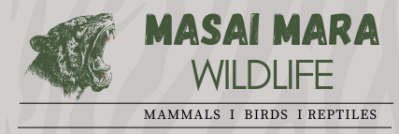Small-Spotted Genet (Genetta genetta)
- Size:
- Body-Tail Length (BT): 100 cm (39 inches)
- Gestation: 10–11 weeks
- Recognition: The Small-Spotted Genet has an off-white coat with linear black spots, a black stripe running down its spine, and an evenly barred tail with a white tip. Its sleek, elongated body and cat-like appearance make it easy to identify.
- Habits: This nocturnal species is known for its agility and climbing skills. However, it is more often seen on the ground compared to the Large-Spotted Genet. Small-Spotted Genets are solitary but can become tame around camps and lodges, occasionally being spotted in such environments where food is available.
- Habitat: Prefers drier habitats such as savanna and acacia scrubland.
- Diet: Omnivorous, feeding on fruits, birds, invertebrates, small mammals, and reptiles. Their diet is opportunistic, adapting to the local availability of prey.
Large-Spotted Genet (Genetta tigrina)
- Size:
- Body-Tail Length (BT): 110 cm (43 inches)
- Gestation: 10–11 weeks
- Recognition: The Large-Spotted Genet has a warm-toned coat with irregular rusty blotches, an unevenly barred tail, and a black tip. It is larger and slightly bulkier than the Small-Spotted Genet and is more frequently found in trees.
- Habits: Also nocturnal, the Large-Spotted Genet is more commonly arboreal than its smaller cousin, spending more time in trees. It is solitary but can become tame and habituated around camps, where they may seek out food scraps.
- Habitat: This genet prefers forested areas and mixed woodlands, favoring regions with more cover.
- Diet: Like the Small-Spotted Genet, it is omnivorous and feeds on fruits, birds, small mammals, reptiles, and invertebrates.
Behavior and Shared Traits
Both species of genets are part of the viverrid family, which also includes the African Civet. Genets are skillful climbers but also spend time on the ground, where they hunt small prey like rodents, birds, and reptiles. They are known for their “handstand” scent-marking behavior, where they rub their scent glands against trees or bushes to mark their territory.
Reproduction and Offspring
Genets give birth to 1–5 kittens after a gestation period of 10–11 weeks. The young are born in tree hollows or dense vegetation and remain hidden until they are old enough to follow their mother on hunts. The young typically leave the mother at around six months of age to establish their own territories.
IUCN Conservation Status
- Small-Spotted Genet (Genetta genetta):
- IUCN Status: Least Concern. The Small-Spotted Genet has a wide distribution across Africa and parts of Europe, and while it faces some localized threats such as habitat loss and hunting, its population remains stable and is not currently considered at risk.
- Large-Spotted Genet (Genetta tigrina):
- IUCN Status: Least Concern. This species is similarly widespread, inhabiting a variety of woodland and forest habitats across sub-Saharan Africa. Though it may face habitat destruction and human encroachment, it is adaptable and has a stable population.
Conservation Challenges
Although both species are currently listed as Least Concern, threats include habitat degradation and loss due to agriculture, logging, and human expansion. In some areas, genets are also hunted for their fur or as part of bushmeat trade, though these pressures are not considered severe enough to cause population declines on a large scale. Conservation efforts focus on habitat preservation and reducing human-wildlife conflict, especially in areas where genets come into contact with human settlements.
Interesting Facts
- Genets have scent glands that produce a pungent odor, which they use to mark territory.
- Both species exhibit cat-like behaviors, including vocalizations like meows and purrs, making them fascinating for wildlife enthusiasts to observe.
In conclusion, both the Small-Spotted and Large-Spotted Genets are fascinating and adaptable creatures that are an integral part of the African savanna and woodland ecosystems. Their nocturnal and solitary habits, combined with their agility, make them elusive but rewarding animals to observe during nighttime safaris or around camps in the Masai Mara. Their stable population status ensures that with continued conservation, these remarkable creatures will continue to thrive in their natural habitats.
